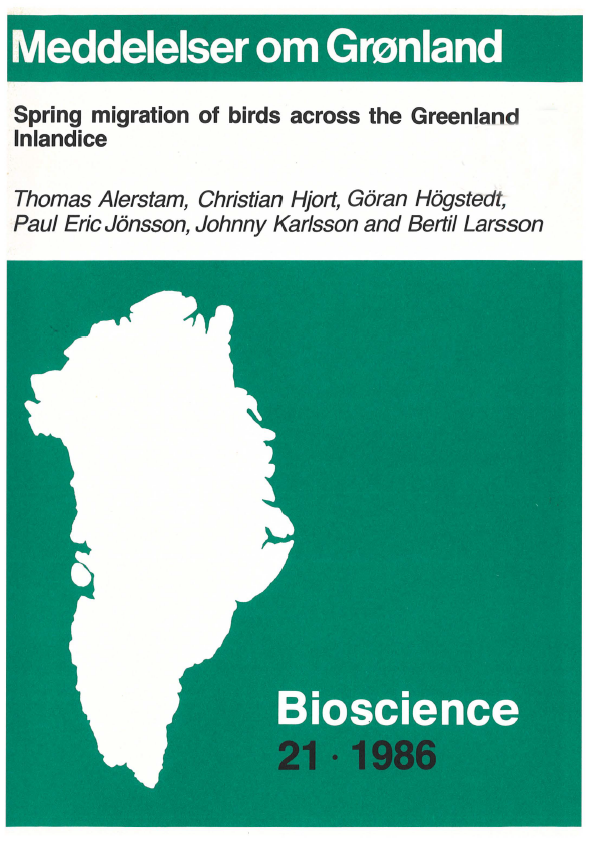Spring migration of birds across the Greenland Inlandice
DOI:
https://doi.org/10.7146/mogbiosci.v21.142346Abstract
Radar observations from a long-range surveillance station in SE Greenland (65°31'N, 37°08'W) during the end of May and beginning of June 1980 and 1982, demonstrated regular bird migration across the Inlandice in both E/SE and W/NW directions. According to supplementary field observations from SE and W Greenland 1980, -82 and -84, and to available information from the literature, the most probable species to carry out a transglacial E/SE-migration in spring are Gavia immer, Clangula hyemalis, Mergus serrator, Anas platyrhynchos and, possibly, Alle ,alle and Larus hyperboreus. These birds probably depart from the ice-free coasts in W Greenland towards breeding sites along the E Greenland coast and, at least in Clangula hyemalis, Iceland and possibly even further to the east. Plectrophenax nivalis and Calcarius lapponicus probably also travel eastwards over the southern Inlandice to SE Greenland breeding sites.
Species involved in the transglacial W/NW-migration comprise geese, Anser albifrons and Branta bernicla, and high arctic waders, Charadrius hiaticula, Arenaria interpres, Calidris canutus and Calidris alba. In addition, it is highly probable that also Oenanthe oenanthe, Sterna paradisaea and Phalaropus lobatus belong to this category.
The geese and high arctic waders depart from staging areas in Iceland to undertake a long-distance flight to breeding grounds in W Greenland (Anser albifrons) or NW Greenland and N Canada. The flight route passes the Sermilik fjord region in SE Greenland, where the migrants shift from a W/WNW course over the Denmark Strait to a WNW/NW course across the Inlandice.
The route from Iceland via Sermilik to NW Greenland and N Canada is about 10% longer than the great circle route across the central and northern Inlandice. However, wind conditions for a high altitude transglacial flight are much less favourable along the great circle route. The observed migration patterns involve the crossing of 450-700 km of inlandice, reaching 2500-2800 m asl, with temperatures about -10°C. The total flight distance from Iceland to NW Greenland and N Canada is 2300-3000 km.
Staging areas for ducks and divers along the Greenland west coast, and for geese and waders in Iceland, are probably of crucial importance for the evolution of the observed transglacial migration patterns. The distance from Iceland to the northernmost part of the Nearctic is smaller than from corresponding spring staging sites in North America. Hence, Iceland serves as a spring-board to Nearctic breeding grounds for Old World winter populations of waders and geese. Staging sites probably have a dual effect as spring-boards and bottle-necks, respectively, for the evolution of migration patterns in arctic birds. Gaps in the circumpolar breeding distribution of arctic species, and a relatively low diversity of species breeding in the sector around Greenland, may be due to competition for limited staging resources in combination with the isolating effects in this sector of sea expanses and the Greenland Inlandice.

Downloads
Published
Issue
Section
License
Coypyright by the authors and the Commision for Scientific Research in Greenland / Danish Polar Center/Museum Tusculanum Press as indicated in the individual volumes. No parts of the publications may be reproduced in any form without the written permission by the copyright owners.

